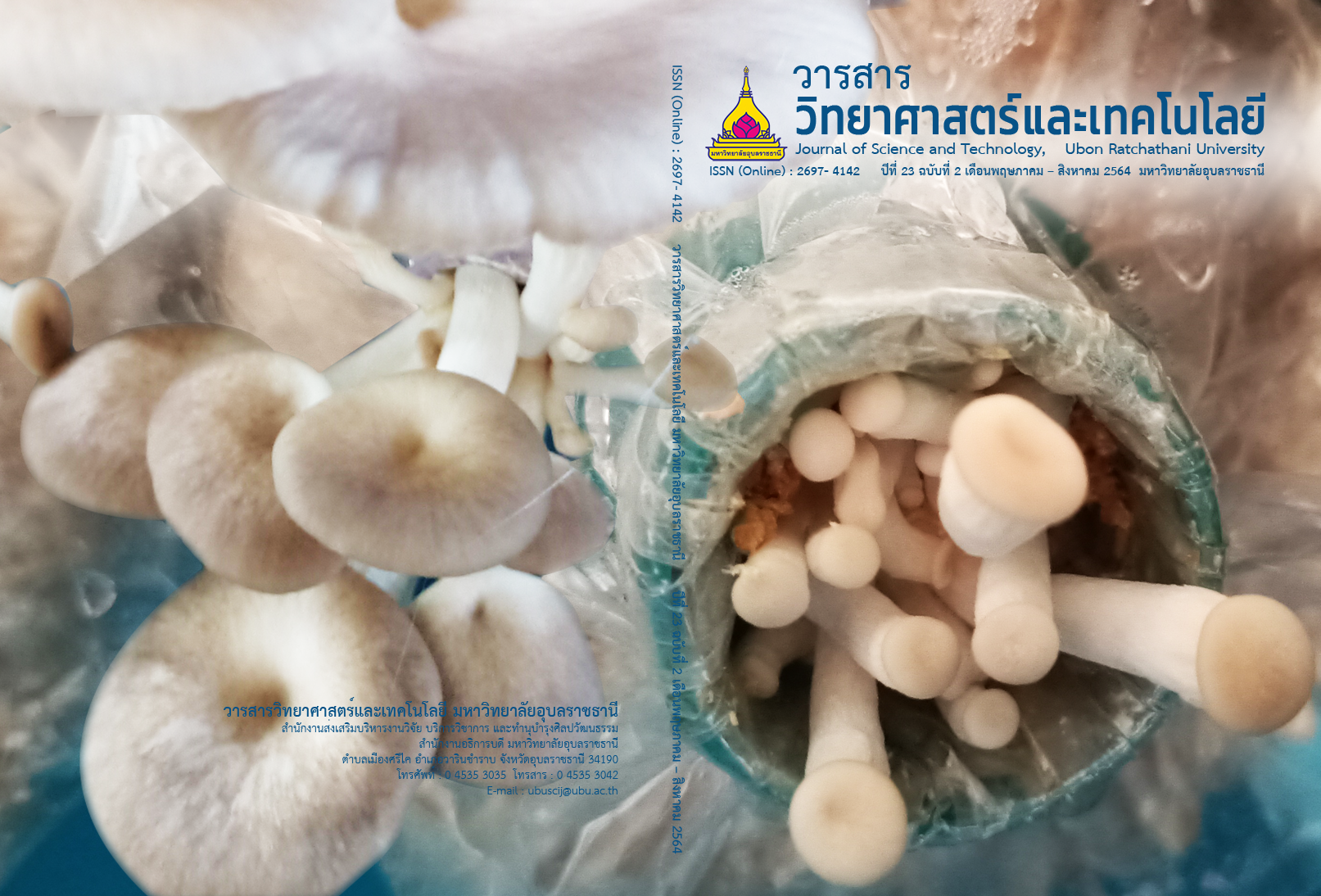วัสดุทางเลือกเพิ่มกำไร: อัตราส่วนหญ้านวลน้อยในวัสดุเพาะเห็ดนางรม
Main Article Content
บทคัดย่อ
เห็ดนางรม (Pleurotus ostreatus) เป็นเห็ดเศรษฐกิจที่บริโภคทุกภูมิภาคในประเทศไทยและทั่วโลก มีคุณค่าทางโภชนาการสูงและสรรพคุณทางยาหลายประการ เพาะเลี้ยงไม่ยากและให้ผลตอบแทนที่ดี เกษตรกรจึงนิยมเพาะโดยใช้ขี้เลื่อยยางพาราเป็นวัสดุเพาะหลักซึ่งปัจจุบันมีราคาสูงขึ้น ด้วยเหตุนี้ผู้วิจัยจึงศึกษาวัสดุทางเลือกที่ลดต้นทุนและเพิ่มกำไรผลผลิตเห็ด โดยใช้ขี้เลื่อยยางพาราผสมหญ้านวลน้อยที่เหลือทิ้งและหาได้ในท้องถิ่น 4 อัตราส่วนๆละ 9 ซ้ำ คือ 100:0 (ชุดควบคุม), 75:25, 50:50 และ 25:75 เปอร์เซ็นต์ แต่ละอัตราส่วนผสมรำละเอียด ยิปซั่ม ปูนขาว และดีเกลือ น้ำหนัก 6, 2, 1 และ 0.2 กิโลกรัม/วัสดุเพาะหลัก 100 กิโลกรัม ตามลำดับ วัสดุเพาะหนัก 700 กรัม/ก้อน เมื่อเก็บผลผลิตเห็ดจำนวน 3 รุ่น พบว่า ขี้เลื่อยไม้ยางพาราผสมหญ้านวลน้อยในอัตราส่วน 75:25 ส่งเสริมน้ำหนักดอกเห็ดและประสิทธิภาพทางชีวภาพเฉลี่ยสูงที่สุด เท่ากับ 48.5 กรัม และ 31.6 เปอร์เซ็นต์/ก้อน/รุ่น ตามลำดับ ให้ดอกเห็ดที่มีความกว้างของหมวกตั้งแต่ 3 เซนติเมตรขึ้นไป จำนวนเฉลี่ย 4.6 ดอก/ก้อน/รุ่น น้อยกว่าอัตราส่วน 25:75 แต่ดอกเห็ดมีลักษณะสมบูรณ์และขนาดใหญ่กว่า โดยอัตราส่วน 75:25 ส่งเสริมน้ำหนักดอก จำนวนดอก และประสิทธิภาพทางชีวภาพ สูงกว่าชุดควบคุม 5.0, 12.2 และ 51.2 เปอร์เซ็นต์ ตามลำดับ หากนำผลการวิจัยนี้ไปปรับใช้ในฟาร์มเห็ดนางรมขนาดเล็กที่มีก้อนเชื้อจำนวน 4,000 ก้อน ช่วยให้กำไรจากการจำหน่ายดอกเห็ดและก้อนเชื้อสูงกว่าการใช้ขี้เลื่อยยางพารา 100 เปอร์เซ็นต์ เป็นจำนวนเงิน 8,120 บาท หรือ 16.1 เปอร์เซ็นต์/ครึ่งรอบการผลิต 3 จาก 6 รุ่น หญ้านวลน้อยจึงเป็นวัสดุทางเลือกหนึ่งที่น่าสนใจในลดต้นทุนและเพิ่มกำไรผลผลิตเห็ดนางรมของเกษตรกร โดยเฉพาะในช่วงที่วิกฤตของหนี้ครัวเรือนเพิ่มสูงขึ้นในปัจจุบัน
Article Details
บทความที่ได้รับการตีพิมพ์เป็นลิขสิทธิ์ของ วารสารวิทยาศาสตร์และเทคโนโลยี มหาวิทยาลัยอุบลราชธานี
ข้อความที่ปรากฏในบทความแต่ละเรื่องในวารสารวิชาการเล่มนี้เป็นความคิดเห็นส่วนตัวของผู้เขียนแต่ละท่านไม่เกี่ยวข้องกับมหาวิทยาลัยอุบลราชธานี และคณาจารย์ท่านอื่นๆในมหาวิทยาลัยฯ แต่อย่างใด ความรับผิดชอบองค์ประกอบทั้งหมดของบทความแต่ละเรื่องเป็นของผู้เขียนแต่ละท่าน หากมีความผิดพลาดใดๆ ผู้เขียนแต่ละท่านจะรับผิดชอบบทความของตนเองแต่ผู้เดียว
เอกสารอ้างอิง
[2] Adebayo, E. A. and Oloke, J. K. 2017. Oyster mushroom (Pleurotus species); a natural functional food. Journal of Microbiology, Biotechnology and Food Sciences. 7(3): 254-264.
[3] Paul, C., Roy, T. and Das, N. 2017. Potentiality of oyster mushroom (Pleurotus spp.) in medicine. Annals of Food Processing and Preservation. 2(2): 1014.
[4] Deepalakshmi, K. and Mirunalini, S. 2014. Pleurotus ostreatus: an oyster mushroom with nutritional and medicinal properties. Journal of Biochemical Technology. 5(2): 718-726.
[5] Thai market. 2021. Product Price: Oyster Mushroom. https://talaadthai.com/product/9-67-05-oyster-mushroom. Accessed 9 February 2021. (in Thai)
[6] Technologychaoban. 2017. Secrets to Buying Para Rubber Sawdust for Mushroom Cultivation. https://www.sentangsedtee.com/farming-trendy/article_40275. Accessed 9 February 2021. (in Thai)
[7] Olfati, J. A. and Peyvast, Gh. 2008. Lawn clippings for cultivation of oyster mushroom. International Journal of Vegetable Science. 14(2): 98-103.
[8] Abdul-Hadi, A. 2010. Influence of cogon grass and kind of supplementation the biological efficiency and storage of Pleurotus ostreatus. Diyala Agricultural Sciences Journal. 2(1): 208-235.
[9] Tesema, G. and Keneni, A. 2019. Nutrient compositions and optimization of elephant grass (Pennisetum purpureum) stem to cotton seed proportion for the cultivation of oyster mushroom (Pleurotus
ostreatus) at Ambo western, Ethiopia. Greener Journal of Agricultural Sciences. 9(3): 322-336.
[10] Bernardia, E. and et al. 2019. Productivity, biological efficiency and bromatological composition of Pleurotus sajor-caju growth on different substrates in Brazil. Agriculture and Natural Resources. 53: 99-105.
[11] Haastrup, N. O. and Aina oduntan, A. O. 2019. Comparative study on the growth and yield of Pleurotus sajor-caju mushroom cultivated on Pennisetum purpureum (Elephant grass) and sawdust of Triplochiton scleroxylon as an environmental control measure. International Journal of Research and Innovation in Applied Science. 4(5): 53-55.
[12] Garg, P. and et al. 2017. Conversion of urban waste into highly nutritious food by Pleurotus cultivation. IOSR Journal of Biotechnology and Biochemistry. 3(4): 15-18.
[13] Puechkaset. 2016. Benefits and Planting of Manila Grass. https://puechkaset.com. Accessed 9 February 2021. (in Thai)
[14] National bureau of agricultural commodity and food standards. 2021. Agricultural Standard: Oyster mushroom. https://www.acfs.go.th/#/ standard-commodity/search. Accessed 9 February 2021. (in Thai)
[15] Keneni, A. 2018. Yield response of oyster mushroom (Pleurotus ostreatus) cultivated on creeping bent grass (Agrostis sp.) biomass supplemented with wheat bran, cotton seed and waste paper. Journal of Natural Sciences Research. 8(21): 68-75.
[16] Tirkey, V. J., Simon, S. and Lal, A. A. 2017. Efficacy of different substrates on the growth, yield and nutritional composition of oyster mushroom Pleurotus florida (Mont.) Singer. Journal of Pharmacognosy and Phytochemistry. 6(4): 1097-1100.
[17] Masevhe, M. R., Soundy, P. and Taylor, N. J. 2016. Alternative substrates for cultivating oyster mushrooms (Pleurotus ostreatus). South African Journal of Plant and Soil. 33(2): 97-103.
[18] Vieira, F. R. and Andrade, M. C. N. 2016. Optimization of substrate preparation for oyster mushroom (Pleurotus ostreatus) cultivation by studying different raw materials and substrate preparation conditions (composting: phases I and II). World Journal of Microbiology and Biotechnology. 32(11): 190.
[19] Alia, N. and et al. 2018. Cultivation of Pleurotus ostreatus on oil palm fronds mixed with rubber tree sawdust. Chemical Engineering Transactions. 63: 547-552.
[20] Hanafi, N. D. and et al. 2018. Analysis of botanical composition and nutrient content on natural pastures in Samosir island of Samosir regency. International conference on agriculture, environment and food security. IOP Conference Series: Earth and Environmental Science. 122(1): 012131.
[21] Ritota, M. and Manzi, P. 2019. Pleurotus spp. cultivation on different agri-food by-products: example of biotechnological. Application Sustainability. 11: 1-26.
[22] Sbhatu, D. B., Abraha, H. B. and Fisseha, H. T. 2019. Grey oyster mushroom biofarm for small-scale entrepreneurship. Advances in Agriculture. 1-6.
[23] Bernardia, E. 2019. Productivity, biological efficiency and bromatological composition of Pleurotus sajor-caju growth on different substrates in Brazil. Agricultural and Nature Resources. 53: 99-105.
[24] Siqueira, F. and et al. 2012. Cultivation of Pleurotus mushrooms in substrates obtained by short composting and steam pasteurization. African Journal of Biotechnology. 11(53): 11630-11635.
[25] Fanadzo, M. and et al. 2010. Evaluation of various substrates and supplements for biological efficiency of Pleurotus sajor-caju and Pleurotus ostreatus. African Journal of Biotechnology. 9(19): 2756-2761.
[26] Ayae, A. and Suwanno, S. 2012. Utilization of lignocellulosic waste from paper cone for oyster mushroom cultivation. Proceedings of 50th Kasetsart University Annual Conference: Science, Natural Resources and Environment. 392-400.
[27] Cueva, M. B. R. , Hernández, A. and Niño-Ruiz, Z. 2017. Influence of C/N ratio on productivity and the protein contents of Pleurotus ostreatus grown in differents residue mixtures. Revista FCA UNCUYO. 49(2): 331-334.
[28] National research agency. 2019. Knowledge Guide: Knowledge Management and Technology transfer Value Added and Utilization of Microorganisms for Fermented Products and Mushroom Cultivation. 66 pp. (in Thai)
[29] Bank of Thailand. 2021. Loans to The Household Sector. https://www.bot.or.th/App/BTWS_STAT/Statistics/BOTWEBSTAT.aspx?reportID=775&Language=TH. Accessed 9 February 2021. (in Thai)


